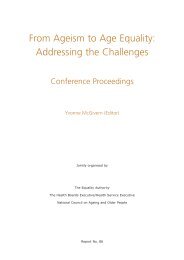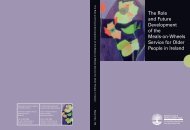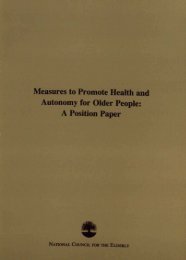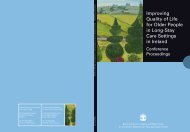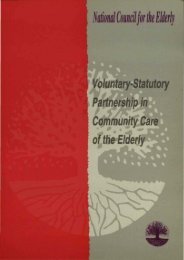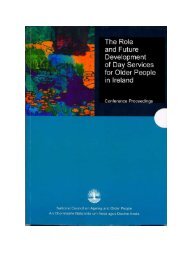Improving Quality of Life for Older People in Long-Stay Care ...
Improving Quality of Life for Older People in Long-Stay Care ...
Improving Quality of Life for Older People in Long-Stay Care ...
- No tags were found...
Create successful ePaper yourself
Turn your PDF publications into a flip-book with our unique Google optimized e-Paper software.
A small number <strong>of</strong> private nurs<strong>in</strong>g homes listed had closed. There were alsodifferences between how facilities were categorised on the lists received from thehealth boards and how the facilities categorised themselves. Most discrepanciesoccurred where a facility categorised as voluntary <strong>in</strong> the list from the health boardcategorised itself as private. Also, some facilities listed as welfare homes <strong>in</strong> thehealth board data categorised themselves as public geriatric homes. There were,there<strong>for</strong>e, considerable difficulties <strong>in</strong> categoris<strong>in</strong>g facilities. Pragmatic decisionswere made <strong>in</strong> light <strong>of</strong> these discrepancies; lists were modified to ensureconsistency and some facilities were recategorised. In addition, a web search <strong>for</strong>new facilities was also undertaken and new facilities added, where appropriate.4.4.1 Questionnaire Design84The questionnaire used <strong>in</strong> the survey was developed from that used <strong>in</strong> theO’Connor and Walsh (1986) study as one <strong>of</strong> the aims <strong>of</strong> this study was to allowsome comparison between the two studies. The survey <strong>in</strong>strument, there<strong>for</strong>e, hadto be broadly comparable to the <strong>in</strong>strument used <strong>in</strong> 1986. This prior study, however,only focused on the private and voluntary long-stay sector. Follow<strong>in</strong>g a review <strong>of</strong>the literature and exam<strong>in</strong>ation <strong>of</strong> data from focus groups, a number <strong>of</strong> changes tothe survey <strong>in</strong>strument were made to reflect changes <strong>in</strong> the health and social caresystem <strong>in</strong> the <strong>in</strong>terim and the need <strong>for</strong> the questionnaire to be equally applicable topublic and private facilities (Appendix One). Questionnaires were coded accord<strong>in</strong>gto type <strong>of</strong> facility, health board region and number <strong>of</strong> facilities <strong>in</strong> that region.4.4.2 Pilot SurveyPrior to the ma<strong>in</strong> survey, a pilot questionnaire was sent to thirty long-stay facilitiesacross the country (Table 4.2). The pilot sample was stratified to mirror thecharacteristics <strong>of</strong> the population as a whole us<strong>in</strong>g the follow<strong>in</strong>g criteria:representation from the five categories <strong>of</strong> long-stay facilities<strong>in</strong>clusion <strong>of</strong> at least one facility <strong>in</strong> each category from each health board area(where possible)appropriate urban/rural mixthe total number <strong>of</strong> facilities used as pilot sites reflected the percentage<strong>of</strong> total long-stay beds <strong>in</strong> each <strong>of</strong> the categories.<strong>Improv<strong>in</strong>g</strong> <strong>Quality</strong> <strong>of</strong> <strong>Life</strong> <strong>for</strong> <strong>Older</strong> <strong>People</strong> <strong>in</strong> <strong>Long</strong>-<strong>Stay</strong> <strong>Care</strong> Sett<strong>in</strong>gs <strong>in</strong> Ireland







